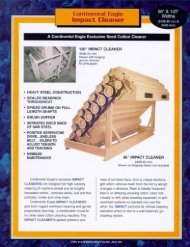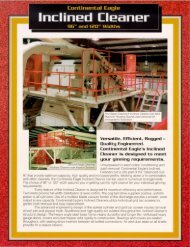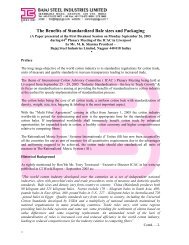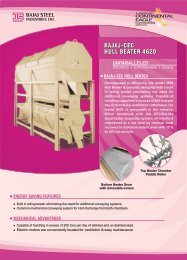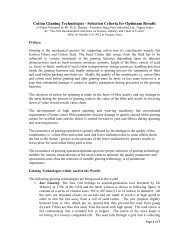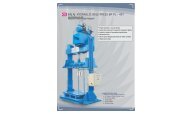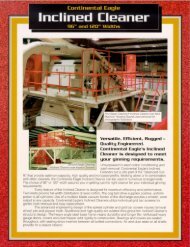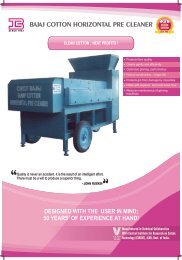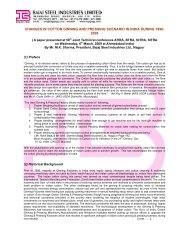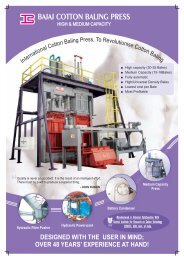recent advances in ginning for lowering cost and ... - Bajaj Group
recent advances in ginning for lowering cost and ... - Bajaj Group
recent advances in ginning for lowering cost and ... - Bajaj Group
Create successful ePaper yourself
Turn your PDF publications into a flip-book with our unique Google optimized e-Paper software.
(RECENT ADVANCES IN GINNING FOR LOWERING COST AND IMPROVING OF EFFICIENCY)<br />
# 7 #<br />
5.3. User Friendl<strong>in</strong>ess:<br />
Flexibility <strong>for</strong> different capacity requirement <strong>and</strong> suitability to different varieties of cotton as well as operational<br />
ease are important <strong>for</strong> user friendl<strong>in</strong>ess. Now technology wise user friendl<strong>in</strong>ess may be understood from<br />
follow<strong>in</strong>g:<br />
5.3 (a) Saw G<strong>in</strong>s:<br />
Saw G<strong>in</strong>s are normally usable <strong>for</strong> upl<strong>and</strong> cotton <strong>and</strong> not suitable <strong>for</strong> extra-long cotton. Moreover, each<br />
mach<strong>in</strong>e is of very high capacity hence <strong>in</strong> case of lower capacity requirement no adjustment is possible.<br />
Further, this g<strong>in</strong> generates higher neps <strong>and</strong> cuts the length of fibre. There has not been any improvement <strong>in</strong><br />
these parameters by the <strong>recent</strong> <strong>advances</strong> only g<strong>in</strong>n<strong>in</strong>g speed has improved, hence comparative user<br />
friendl<strong>in</strong>ess has not improved <strong>in</strong> saw g<strong>in</strong>.<br />
5.3 (b) Rotobar G<strong>in</strong>s<br />
Rotobar G<strong>in</strong>s are usable <strong>for</strong> long <strong>and</strong> extra-long staple cotton <strong>and</strong> not usable <strong>for</strong> short staple cotton. Further,<br />
ung<strong>in</strong>ned cotton goes with seed which can only be partially recovered. This also causes significant seed cuts,<br />
s<strong>in</strong>ce the <strong>recent</strong> <strong>advances</strong> have not improved upon these parameters <strong>and</strong> focused only on higher outturn<br />
there is no enhancement <strong>in</strong> user friendl<strong>in</strong>ess.<br />
5.3 (c) Double Roller G<strong>in</strong>:<br />
This g<strong>in</strong> is usable <strong>for</strong> any variety of cotton i.e. short, long or extralong staple by simple adjustments of sett<strong>in</strong>gs<br />
<strong>and</strong> reta<strong>in</strong>s maximum fibre length as well as natural fibre parameters. This g<strong>in</strong>n<strong>in</strong>g mach<strong>in</strong>e can be used <strong>for</strong><br />
all type of capacity requirements i.e. small, medium, large. The mach<strong>in</strong>e be<strong>in</strong>g very simple it can be used <strong>in</strong><br />
rural atmosphere hence can provide a local solution to group of farmers <strong>for</strong> value addition <strong>in</strong> cotton. S<strong>in</strong>ce the<br />
<strong>recent</strong> <strong>advances</strong> have improved productivity as well as controlled the vibrations, thereby reduc<strong>in</strong>g the<br />
ma<strong>in</strong>tenance has improved user friendl<strong>in</strong>ess.<br />
6. Salient features of Double Roller G<strong>in</strong>n<strong>in</strong>g Technology<br />
To have a better underst<strong>and</strong><strong>in</strong>g of the <strong>recent</strong> <strong>advances</strong> <strong>in</strong> Double Roller G<strong>in</strong>n<strong>in</strong>g Technology, it may be<br />
beneficial to have a overall look on the salient features of ‘BAJAJ’ Double Roller G<strong>in</strong>n<strong>in</strong>g Mach<strong>in</strong>e<br />
manufactured by <strong>Bajaj</strong> Steel Industries Limited India who are the largest <strong>in</strong> the segment.<br />
6.1. Gentle G<strong>in</strong>n<strong>in</strong>g: No damage to Fibres:<br />
Double Roller G<strong>in</strong>s work on the pr<strong>in</strong>ciple of frictional <strong>for</strong>ce between stationary knife <strong>and</strong> the roller.<br />
Dur<strong>in</strong>g the g<strong>in</strong>n<strong>in</strong>g process, the gripped fibres experience tension tend<strong>in</strong>g to elongate them. When elongation<br />
<strong>for</strong>ce exceeds the <strong>for</strong>ce of attachment of the fibre to the seed, the fibre gets separated i.e. G<strong>in</strong>ned. The <strong>for</strong>ce<br />
of attachment of the fibre to the seed is much less than strength of fibre, hence the fibre damage / breakage<br />
does not happen <strong>in</strong> DR GIN as <strong>in</strong> case of saw g<strong>in</strong>n<strong>in</strong>g. Further, seed cotton do not travel throughout the width<br />
as <strong>in</strong> case of Rotobar G<strong>in</strong> <strong>and</strong> there is no space available between Stationary Back Knife <strong>and</strong> Roller <strong>for</strong> seed<br />
to enter, hence no seed cut. Moreover, the slots from where the seed is passed are hav<strong>in</strong>g the sizes suitable<br />
to pass the g<strong>in</strong>ned seeds only on Double Roller G<strong>in</strong> hence no ung<strong>in</strong>ned cotton can go with seeds while <strong>in</strong> the<br />
Rotobar a substantial quantity of ung<strong>in</strong>ned seed cotton goes with cotton seed which cannot be reclaimed fully.<br />
The fibres of cotton are located on all surface area of the seed, there<strong>for</strong>e it is not possible to separate all<br />
fibres <strong>in</strong> a s<strong>in</strong>gle shot. In s<strong>in</strong>gle shot few fibre rema<strong>in</strong>s with seed result<strong>in</strong>g lower l<strong>in</strong>t recovery. This problem<br />
has been overcome by oscillat<strong>in</strong>g knife <strong>in</strong> the Double Roller G<strong>in</strong>n<strong>in</strong>g.The oscillat<strong>in</strong>g knives (mov<strong>in</strong>g knives)<br />
beats / drags the seeds from top to opposite direction caus<strong>in</strong>g separation of fibres from the seed end. This<br />
process is repeated a number of times till all sp<strong>in</strong>nable fibres are separated from the seeds while <strong>in</strong> S<strong>in</strong>gle<br />
Roller Rotary Knife G<strong>in</strong>n<strong>in</strong>g the seed boll travels throughout the width <strong>and</strong> many time gets crushed below the<br />
tip of rotat<strong>in</strong>g multiple knifes, caus<strong>in</strong>g oil spread / tack<strong>in</strong>ess, spoil<strong>in</strong>g cotton fibre. Moreover, <strong>in</strong> Rotobar<br />
G<strong>in</strong>n<strong>in</strong>g lot of seed cotton goes ung<strong>in</strong>ned with seeds which is never fully recovered / reclaimed, hence the<br />
output is always lower. In the Saw G<strong>in</strong>, fibre gets cut leav<strong>in</strong>g extra length on seed due to rotat<strong>in</strong>g motion of<br />
saws, f<strong>in</strong>ally result<strong>in</strong>g <strong>in</strong> lower outturn.<br />
Contd. ….8.



